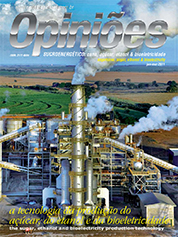Thales José Velho Barreto de Araújo
Director of Velho Barreto Consultoria and ECO Tecnologia Industrial
Op-AA-27
Distillation in the sugar-based energy industry
Distillation, probably conceived by alchemists, is the physical separation process based on differences between the boiling points (the points of equilibrium between liquid and vapor of liquid mixtures) of two or more substances. In the past, alchemists’ philosophical concepts concerning the composition and transformation of substances were a part of the fundaments with which one attempted to obtain elixirs, medicinal waters, extracts, and distillates from alcohol, called “spirits”.
Such knowledge was considered divine and sacred, and was intended to remain secret. Hence, in the people’s mind, beakers, retorts and distillation columns were associated both with alchemists and chemists in their labs. Nowadays, the fractioning of oil, which results in really useful products for mankind (liquefied petroleum gas or LPG, gasoline, diesel, kerosene, asphalt and others) is the best example of processes in which distillation is used in industry.
In addition, distillation is one of the main methods to purify substances used in labs. In the sugar-based energy industry, it is the final phase of the process to obtain ethanol. The first distillation devices were imported from European countries in the first half of the last century, mainly from France, though the manufacturers Morlet and Barbet.
The former Czechoslovakia also supplied devices of renowned technology, made by the Skoda factory. The Brazilian energy context did not require major modifications in such equipmentand the technological development in the last century was limited to empirical adaptations of the European devices to achieve increases in the production capacity.
This model led to an evolution from practical results, with changes in the number of stages in columns, increase in diameter, spacing out between stages and the dimensioning of internal components. The insertion of the sugar and ethanol industry of that early age in the energy matrix resulted in the need to adopt low vapor consuming and high efficiency technologies.
New concepts were applied in dimensioning columns and accessories to reduce load losses, rendering feasible heating with vegetal vapor. From a construction perspective, the leveled flatness of trays contributed to higher efficiency. Yet another essential contribution was to be made by the fermentation process, producing wines with alcohol content in excess of 15%.
In the distillation process, the unequivocal solution is to adopt vacuum technology, widely used in the oil industry and in ethanol production in countries where the cost of energy is high or the raw material is not a source of thermal energy (for instance, beet). Nowadays, such is the case in countries with an ethanol production smaller than that of Brazil, in Central America.
We ought not to expect higher electric energy tariffs upon implementing this technology. It’s just that we are late in doing so. Different configurations of the vacuum process, for example, double effect distillation combined with the utilization of thermo-compression, result in consumption that is less than half that of distillation under pressure, while contributing to making noble products feasible, such as neutral ethanol, with an expanding market for the production of beverages and cosmetics.
In dehydration, development came quickly. Two alternatives have emerged: extractive distillation with glycerin, used in the last century, which underwent a new phase using glycols as dehydrants, and the molecule sieve that became widely accepted and already accounts for a significant volume of anhydric ethanol.
The two processes reduced vapor consumption by half in comparison with traditional cyclohexane. The use of membranes has been analyzed to decrease vapor consumption and the number of columns in the mills, but as yet there is no industrial scale production in Brazil. The immediate consequence of decreasing vapor is the potential increase in electric power generation using bagasse, however we believe this is only the initial step.
Increased availability of bagasse, tips and leaves entails other alternatives, such as second generation production of ethanol and the availability of vapor for vinasse concentration, an essential process to decrease distribution costs of this effluent over great distances. The use of starch produced from micro-algae following hydrolysis for the production of ethanol represents an alternative in the medium term.
In addition, ethanol may be raw material for countless industries, starting with green polymers. In future, more available vapor will be needed to leverage the industry’s revolution with the increase in ethanol production and other products of high aggregate value.Until now we have been technology importers. As occurred in our agriculture, the best alternative is the joining of efforts by companies, development entities and research institutions, so as to finally bring about the yellow-green (Brazilian) technological revolution in the sugar-chemical-energy industry.




